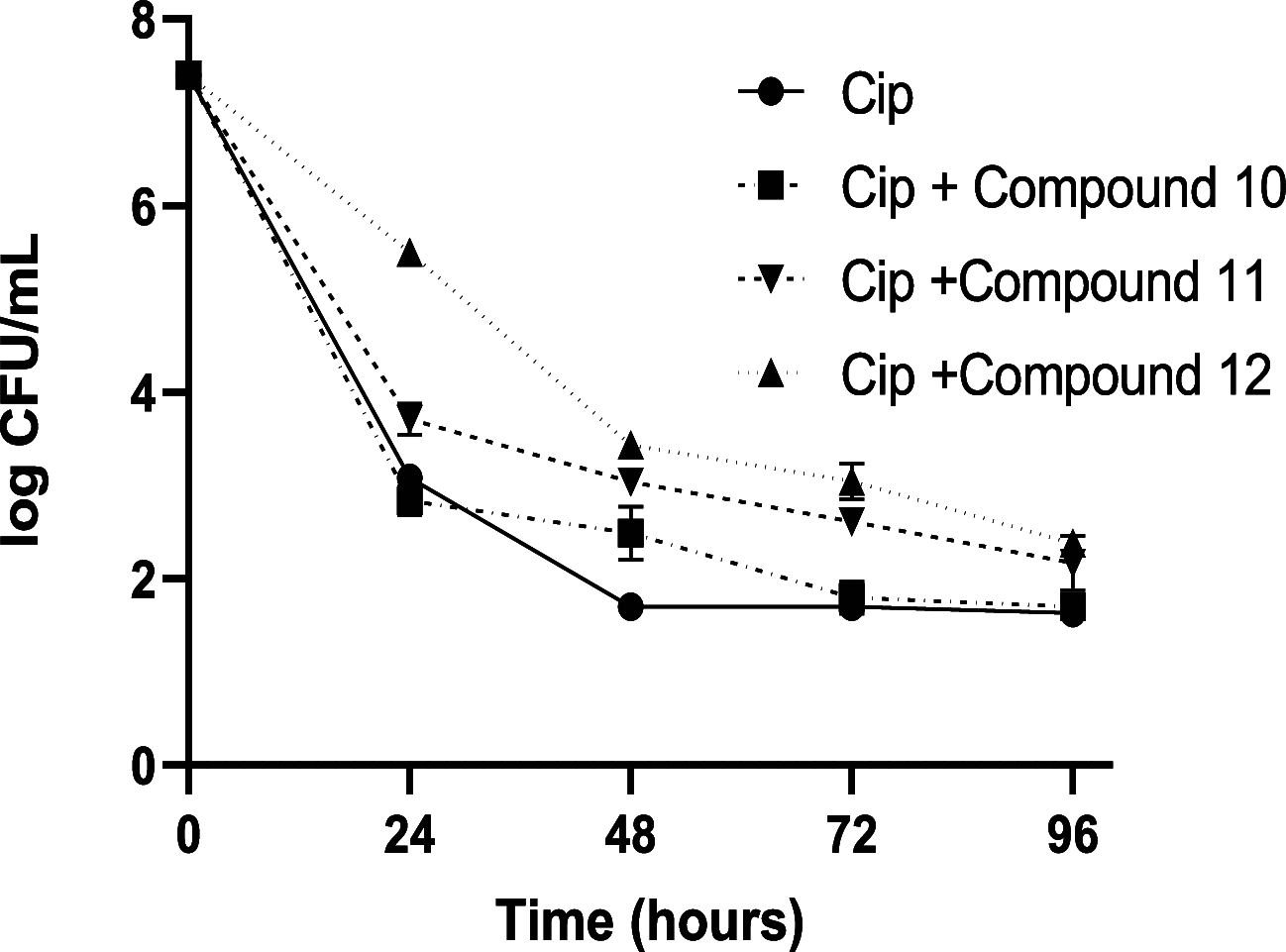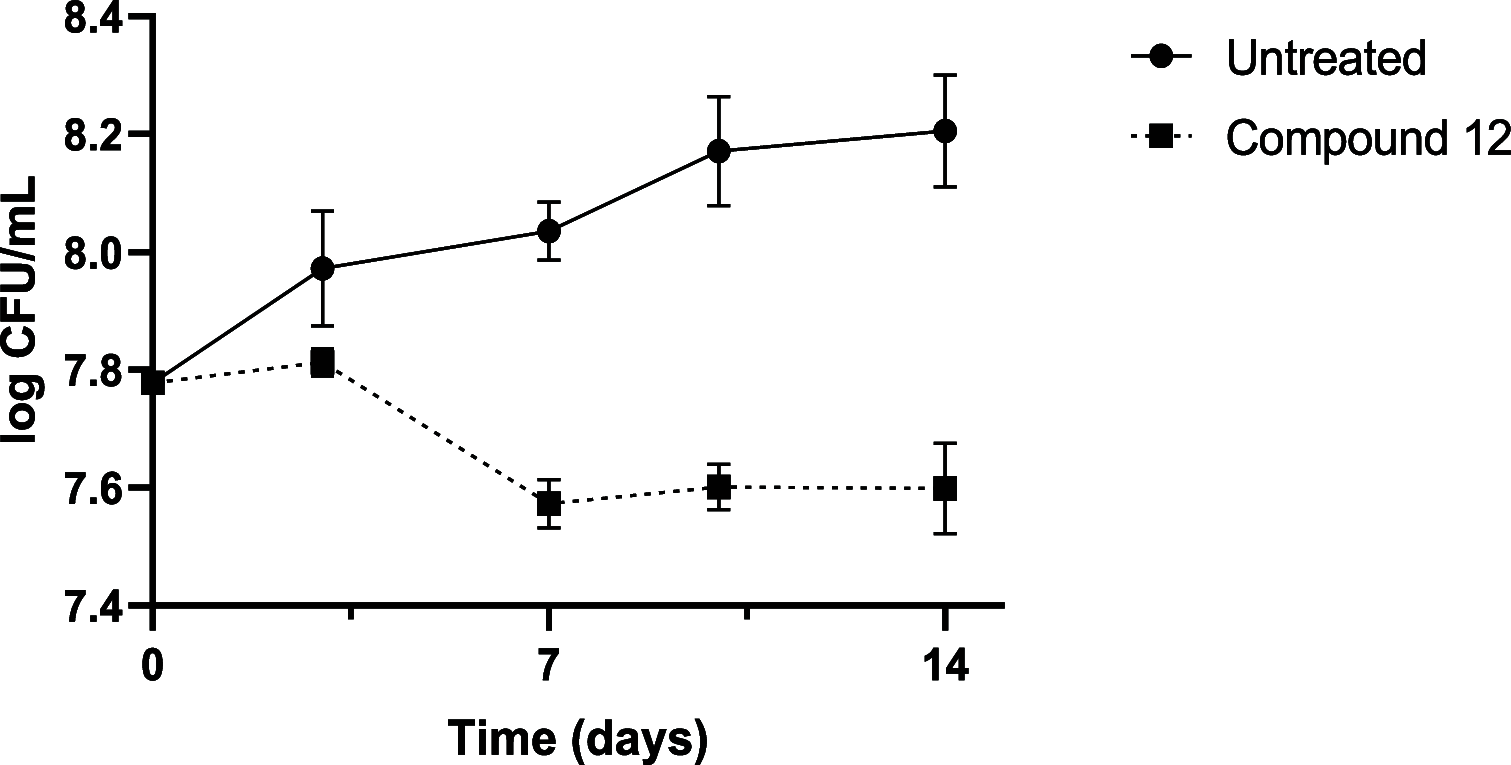C-4-Modified Isotetrones Prevent Biofilm Growth and Persister Cell Resuscitation in Mycobacterium smegmatis
- PMID: 37323400
- PMCID: PMC10268289
- DOI: 10.1021/acsomega.3c00822
C-4-Modified Isotetrones Prevent Biofilm Growth and Persister Cell Resuscitation in Mycobacterium smegmatis
Abstract
Hyperphosphorylated nucleotide (p)ppGpp, synthesized by Rel protein, regulates the stringent response pathway responsible for biofilm and persister cell growth in mycobacteria. The discovery of vitamin C as an inhibitor of Rel protein activities raises the prospect of tetrone lactones to prevent such pathways. The closely related isotetrone lactone derivatives are identified herein as inhibitors of the above processes in a mycobacterium. Synthesis and biochemical evaluations show that an isotetrone possessing phenyl substituent at C-4 inhibit the biofilm formation at 400 μg mL-1, 84 h post-exposure, followed by moderate inhibition by the isotetrone possessing the p-hydroxyphenyl substituent. The latter isotetrone inhibits the growth of persister cells at 400 μg mL-1 f.c. when monitored for 2 weeks, under PBS starvation. Isotetrones also potentiate the inhibition of antibiotic-tolerant regrowth of cells by ciprofloxacin (0.75 μg mL-1) and thus act as bioenhancers. Molecular dynamics studies show that isotetrone derivatives bind to the RelMsm protein more efficiently than vitamin C at a binding site possessing serine, threonine, lysine, and arginine.
© 2023 The Authors. Published by American Chemical Society.
Conflict of interest statement
The authors declare no competing financial interest.
Figures










Similar articles
-
RelZ-Mediated Stress Response in Mycobacterium smegmatis: pGpp Synthesis and Its Regulation.J Bacteriol. 2020 Jan 2;202(2):e00444-19. doi: 10.1128/JB.00444-19. Print 2020 Jan 2. J Bacteriol. 2020. PMID: 31659009 Free PMC article.
-
Synthetic (p)ppGpp Analogue Is an Inhibitor of Stringent Response in Mycobacteria.Antimicrob Agents Chemother. 2017 May 24;61(6):e00443-17. doi: 10.1128/AAC.00443-17. Print 2017 Jun. Antimicrob Agents Chemother. 2017. PMID: 28396544 Free PMC article.
-
Regulation of Growth, Cell Shape, Cell Division, and Gene Expression by Second Messengers (p)ppGpp and Cyclic Di-GMP in Mycobacterium smegmatis.J Bacteriol. 2016 Apr 14;198(9):1414-22. doi: 10.1128/JB.00126-16. Print 2016 May. J Bacteriol. 2016. PMID: 26903417 Free PMC article.
-
Stringent response protein as a potential target to intervene persistent bacterial infection.Biochimie. 2019 Oct;165:67-75. doi: 10.1016/j.biochi.2019.07.006. Epub 2019 Jul 11. Biochimie. 2019. PMID: 31302165 Review.
-
Vitamin C: A Natural Inhibitor of Cell Wall Functions and Stress Response in Mycobacteria.Adv Exp Med Biol. 2018;1112:321-332. doi: 10.1007/978-981-13-3065-0_22. Adv Exp Med Biol. 2018. PMID: 30637707 Review.
Cited by
-
Alleviation of mycobacterial infection by impairing motility and biofilm formation via natural and synthetic molecules.World J Microbiol Biotechnol. 2025 Mar 28;41(4):113. doi: 10.1007/s11274-025-04322-w. World J Microbiol Biotechnol. 2025. PMID: 40148661 Review.
-
Ajoene: a natural compound with enhanced antimycobacterial and antibiofilm properties mediated by efflux pump modulation and ROS generation against M. Smegmatis.Arch Microbiol. 2024 Nov 2;206(12):453. doi: 10.1007/s00203-024-04189-9. Arch Microbiol. 2024. PMID: 39487375
-
Recent advances in the understanding, detection and therapeutic targeting of bacterial recalcitrance.BMC Microbiol. 2025 Aug 8;25(1):488. doi: 10.1186/s12866-025-04210-1. BMC Microbiol. 2025. PMID: 40775282 Free PMC article. Review.
References
LinkOut - more resources
Full Text Sources
Miscellaneous

